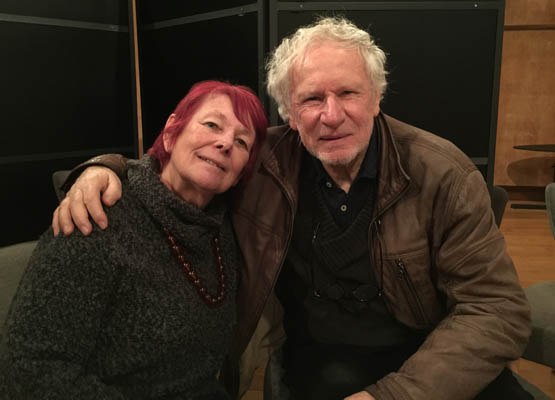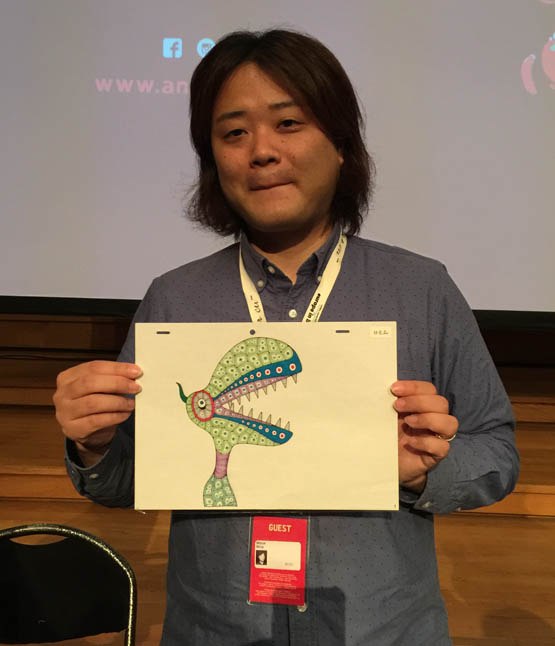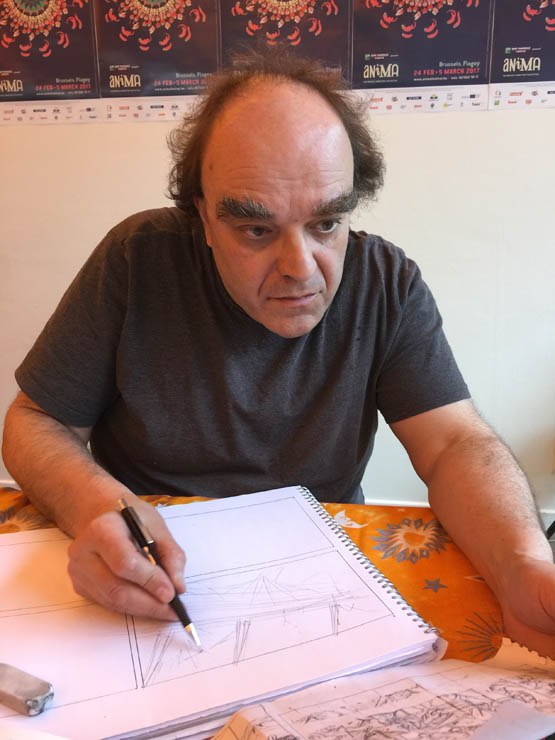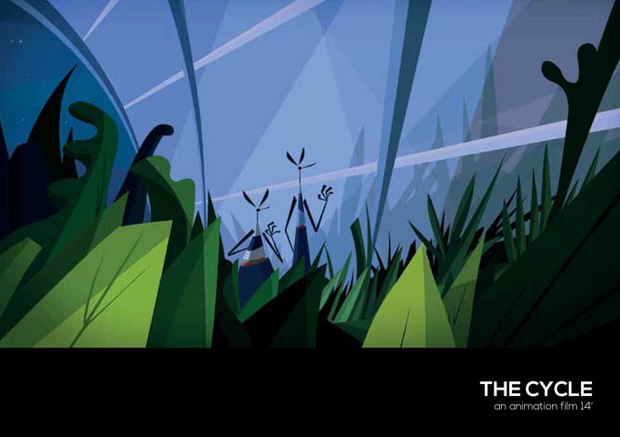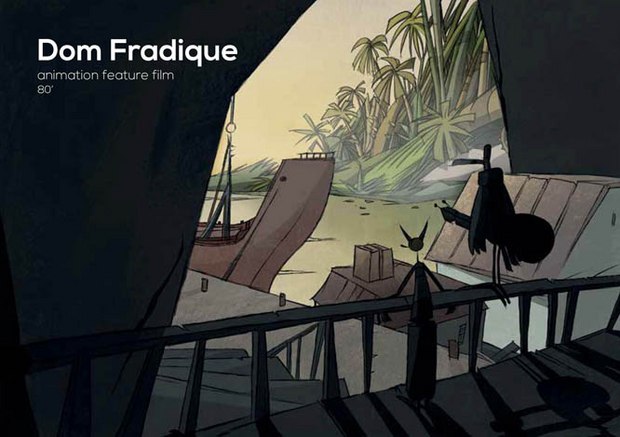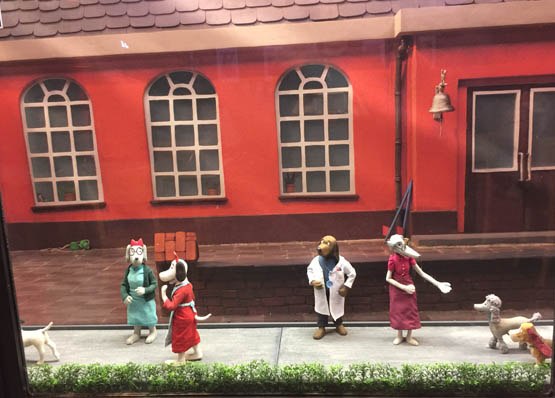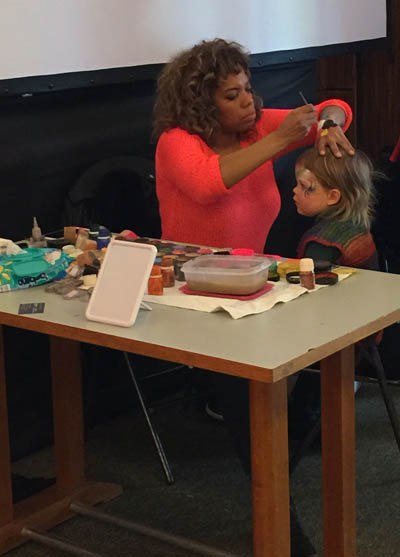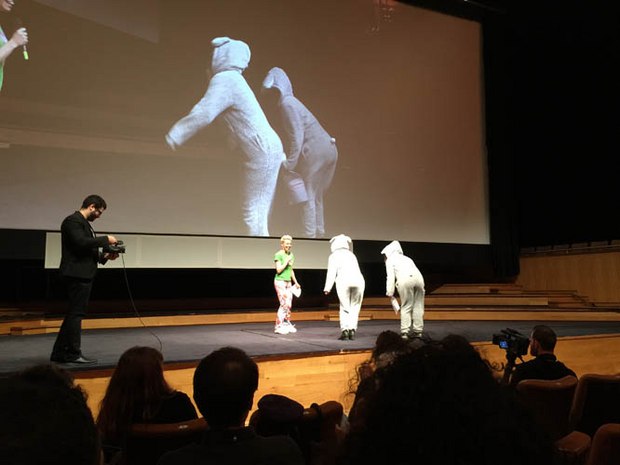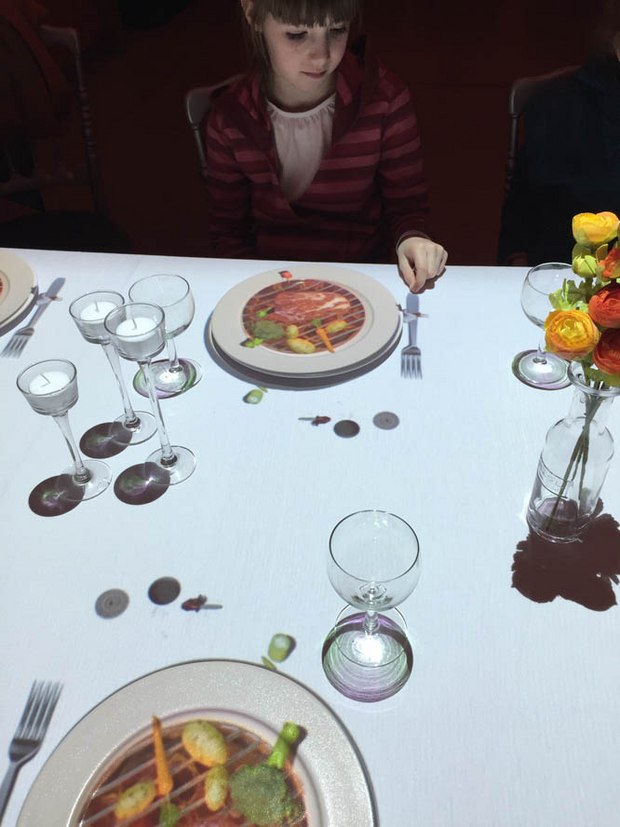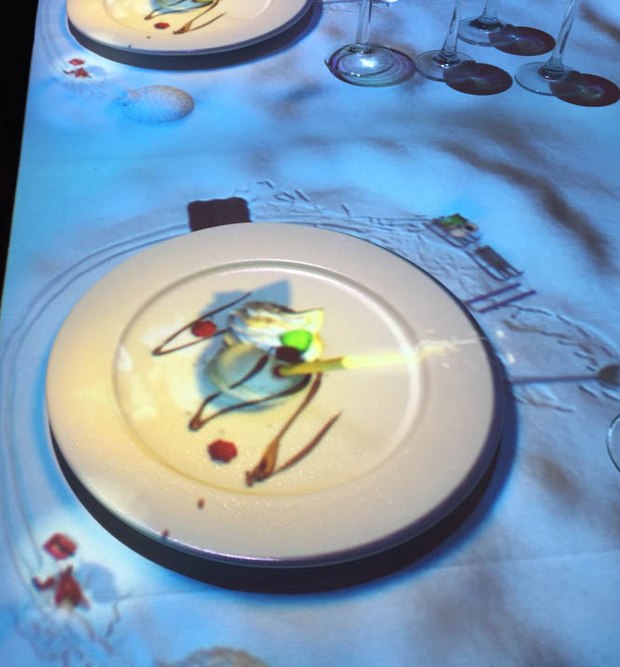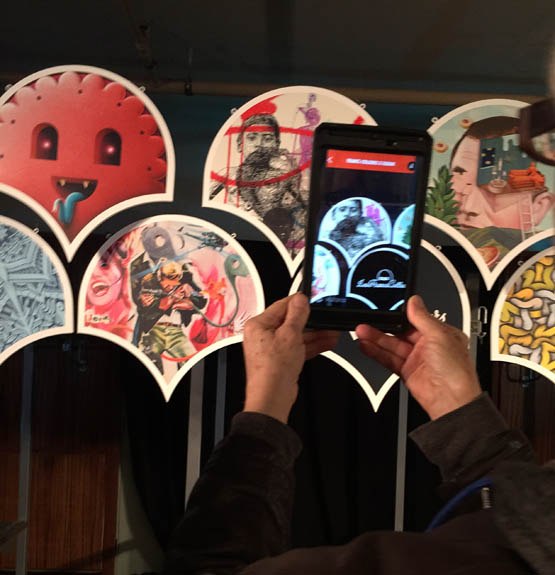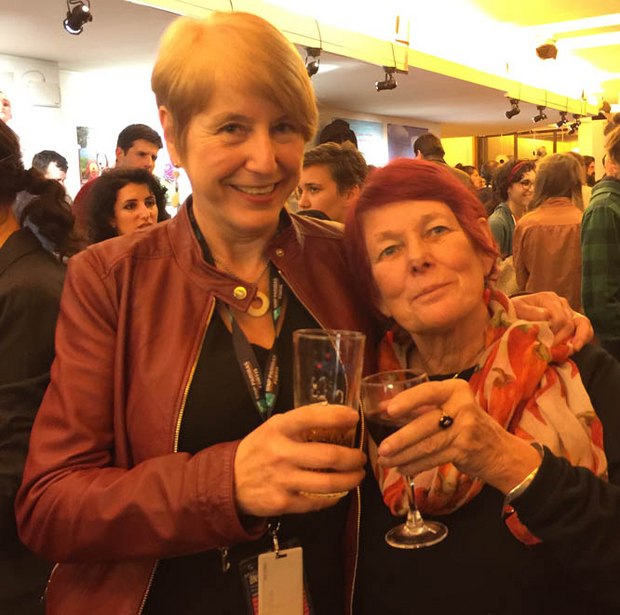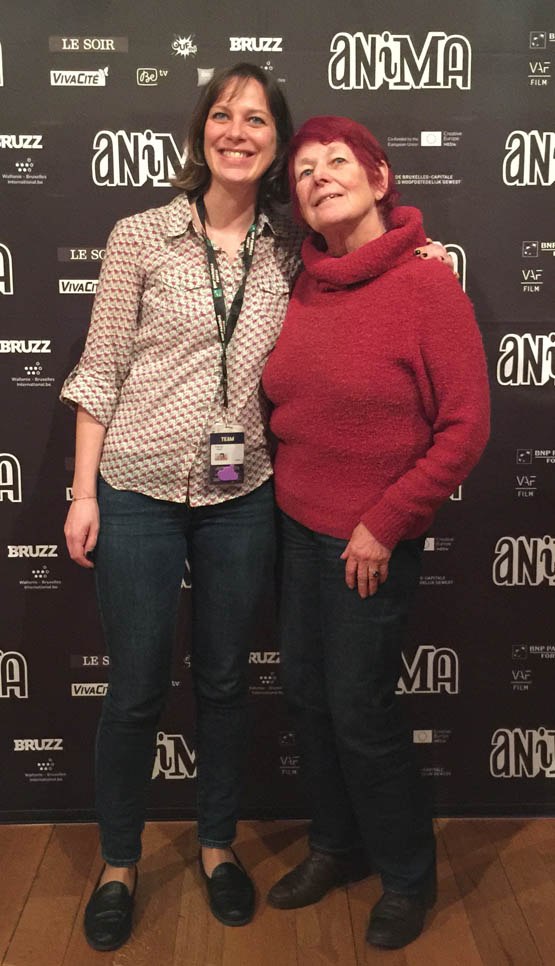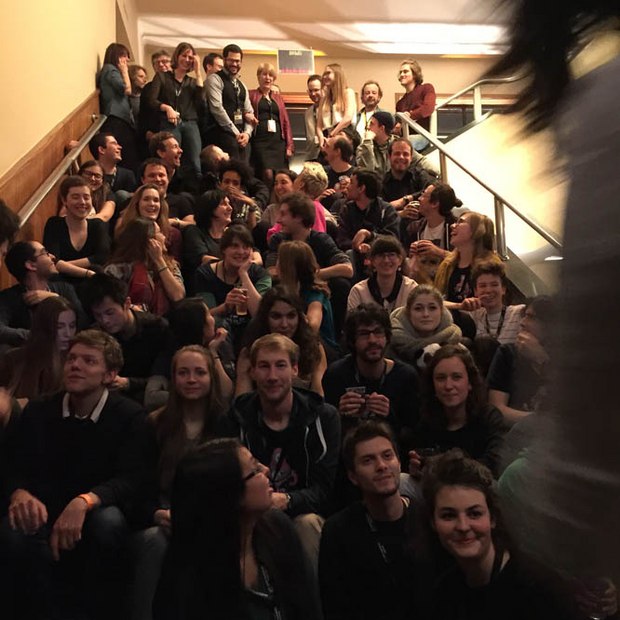It may have been cold and rainy outside but inside the Flagey the films brought rays of sunshine to ANIMA Brussels. With 279 films to be screened in 98 programs there was something to please everyone.
 ANIMA BRUSSELS - 24 FEBRUARY to 5 MARCH 2015 THE FLAGEY in BRUSSELS, BELGIUM - ANIMA BRUSSELS SHINES BRIGHT
ANIMA BRUSSELS - 24 FEBRUARY to 5 MARCH 2015 THE FLAGEY in BRUSSELS, BELGIUM - ANIMA BRUSSELS SHINES BRIGHT
It may have been cold and rainy outside but inside the Flagey the films brought rays of sunshine to ANIMA Brussels. With 279 films to be screened in 98 programs there was something to please everyone.
I am usually drawn to the shorts programs but this year there were several very strong features. Window Horses: The Poetic Persian Epiphany of Rosie Ming completely captivated me. Produced and distributed by the National Film Board of Canada (NFB), the story of Rosie Ming, a young Canadian poet whose mother was Chinese and her father Iranian was directed by Ann Marie Fleming. Rosie lives with her over protective Chinese grandparents and has never traveled alone until she is invited to perform at a poetry festival in Shiraz, Iran.
Once in Iran, Rosie finds herself in the company of foreign poets and Iranians all of whom tell her stories that force her to confront her beliefs about her past, the truth about her Iranian father whom she has always thought had abandoned her and her mother, and the nature of poetry itself. Window Horses combines several styles and techniques of animation. The narrative is presented in one consistent style while the poems and histories are created by different animators. Rosie herself is a stick girl. After watching the 85 minute film I walked out of the theatre thinking about the vast differences between cultures and the simple threads that bind us all together like poetry.
South Korean director Sang-ho Yeon’s feature films are always hard hitting looks at South Korean culture. His 2011 King of Pigs was about bullying in Korean boys’ schools. In 2013 The Fake, an even darker and more violent film, exposed corruption in organized religious cults in his country. His latest feature Seoul Station is a zombie thriller. As the government struggles to shut down the area around a zombie outbreak a father is desperately looking for his runaway daughter. Amidst all of the blood as the zombies take over the city the surprise twist to the story is definitely unexpected. Seoul Station is a prequel to Sang-ho Yeon’s 2016 live action film Train to Busan.
The opening night feature film was Louise in Winter from director Jean-François Laguionie. Jean-François, a guest at the festival, told me that his beautifully hand drawn film is about liberty. When Louise misses the last train out of the little sea-side resort where she summers, she opens herself up to things that she is not used to, recalling her past, her childhood memories, and first loves. He also told me that when he was 9 years old he was left by his mother with his grandmother in Normandy for year where he, like Louise, was free to run in the woods. He also said that he actually did see a body hanging in a tree that was the result of an exploded land mine left over from the war much as Louise does in the film. Louise in Winter is created in the same painterly style as his previous films but in pastel colors rather than in the bright vivid shades of his previous films such as his 2011 The Painting.
Laguionie said that he has 2 films in pre-production. One, Monkey Castle is furthest along. His other film, with the working title Slokem, is based on his father whose idol was Joshua Slokem, the first man to sail single-handed around the world in 1895 to 1898. His father’s dream was to complete and sail a boat he was building in the family garden. He never did finish building the boat but he did instill a lifelong love of the sea in his son.
A retrospective of Laguionie’s films included 4 feature films and a program of 7 short films. From the Lady and the Cellist which won the Annecy Grand Prix in 1964 to Rowing Across the Atlantic, the 1978 Palm d’Or winner at Cannes in 1978 the sea is a recurring theme in his films. His retrospective concluded with a documentary portrait of Jean-Francois’ life and works.
The Anima short film competitions were also very strong. Along with films that have already won numerous awards such as Theodore Ushev’s Blind Vaysha and Frank Dion’s The Head Vanishes there were some lovely new surprises. Italian director Ludovica Ottavian’s hand drawn 5’05” Arzena Velenifera mixes black humor, tango, and murder, a great combination. The film takes place in a ballroom where a woman is overwhelmed by uncontrollable jealousy and furious madness. In her rage she kills all of her annoying or unfaithful lovers to the driving beat of the tango. Ludovica was inspired to make the film by the curious true story of the serial killer Vera Renczi who reportedly poisoned 35 people, including 2 husbands, multiple lovers, and her own son in the 1920’s.
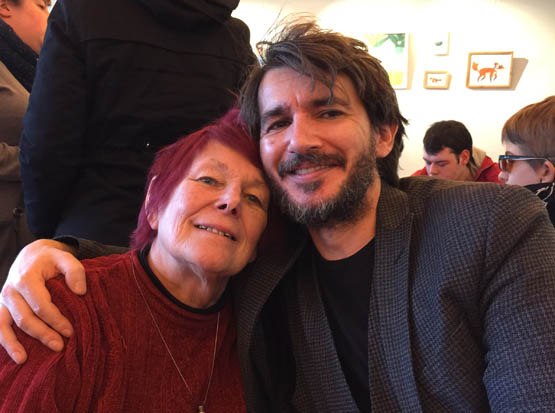
The International Jury awarded the Grand Prix to Anna Budanova for the hauntingly beautiful Among the Black Waves. According to an old Norse legend, the souls of the drowned are transformed into seals. In Anna’s film a hunter steals the skin of one of the mythical creatures, a girl/seal, which prevents her from returning to the sea. Instead, the girl becomes the hunter’s wife, they live a good life together and have a daughter but the wife/seal keeps yearning to return to the sea. The strong 11’ 10” story is intensified by the use of black, white, and grey tones with occasional splashes of red.
Futuranima has become a major part of the festival. It offered a wide range of conferences, professional meetings, and an opportunity to hear a wide range of filmmakers, writers, and producers talk about their work. Sessions were designed not just for professionals but also for students.
The Master Class in Visual Storytelling presented by writer/director Jericca Cleland focused on how images have the power to build story content. She also presented techniques for structuring visuals to support cinematic narrative. Jericca knows what she is talking about. She honed her skills at Pixar working with John Lasseter. Her work includes the design and staging of Finding Nemo, Toy Story 2, and Arther’s Christmas for Sony/Aardman. She is currently writing and directing an animated feature with Nørlum Studio which co-produced The Song of the Sea and Long Way North.
The Pitch Sessions spotlighted Belgian animation productions with an entire morning devoted to writers and illustrators presenting their projects to help find project partners. In the afternoon Walloon and Flemish animation studios discussed their past, present, and future work.
Estonian master storyteller Kasper Jancis took his audience through the script writing process of his latest short film Piano. Kasper is very adept at presenting several parallel story lines in a film and then tying them all together in the end. He is now working on his first animated feature, Morton on the Ship of Fools. Based on a children’s book that Kasper wrote, with music that he composed, Kasper said that it is very different from his previous short films. The film is for children and has dialogue where as his previous short adult animations have relied on sound design and music.
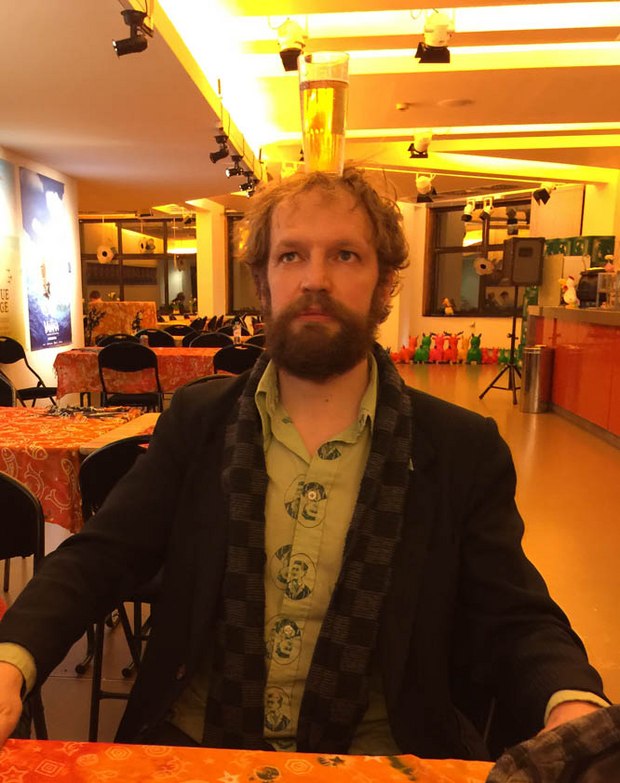
The Italian Stop Motion Wizards session presented by Donato Di Carlo and Virgilio Villoresi was one of the most interesting Futuranima sessions for me. Donato Di Carlo is one of 4 founding members of a creative studio founded in Milan in 2007. The studio is noted for combining artisanal and digital skills to create “handmade” videos and commercials. Di Carlo told me that “the main technique used is stop-motion, but we like to find different technical solutions that allow us to create something new every time and to evolve our designs and research. We usually shoot objects, sets, and puppets built by hand”.
The studio designs projects in 360 degrees, and Donato presented a show reel of their intricate constructions including an entire city built out of paper that was so detailed that you would swear that it was a real city. You can view their show reel and find out more about how they create their amazing commercials and videos at:
Wit coupled with superb technique and attention to detail characterizes independent Milan filmmaker Virgilio Villoresi’s work. My particular favorite of his films and music video’s is Fine, the story of the birth, life, and death of a soldier. What makes the 2’05” film unique is that the soldier is created on Villorest’s hand and was inspired by the concept of hand painting and finger movement. Although it is a simple idea, the detailed painting on his hand, the gestures, and editing combine to create a very clever film. The introduction and end soundtracks, as well as the military salute in the final scene are an homage to Jiri Trinka’s masterpiece The Hand.
When the topic comes to Japanese animation, people generally think of Miyazaki and Studio Ghibli but Mirai Mizue proved at his Futuranima presentation that there is a new generation of abstract animation in Japan. Mizue has a strong obsession toward cels which at first glance almost looks like slides under a microscope until you look close up and then you realize that he has drawn every frame with amazing density. Mirai draws and paints each individual cel on paper then uses digital compositing to create the amazing effects in his films. He told the audience that he has recently been trying to move into what is for him the new territory of minimalistic abstract animation using linear figures. He gave the audience a look at his current work in progress Dreamland, which is based on his memories of an abandoned Japanese fun park located in a town that was completely destroyed by an earthquake. Mizue said that when the park was built no one could ever imagine that it would end up abandoned. He then showed us a brief excerpt from Dreamland, his homage to this piece of Japanese history from his boyhood.
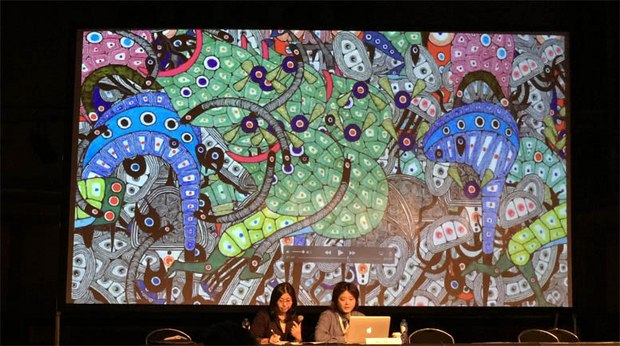
This year the festival spotlighted Portuguese animation. One program paid homage to such great names of Portuguese animation as Abi Feijo, Regina Pessoa, Jose Miguel Ribeiro, and Zepe. The second program was primarily devoted to the talented new generation of animators such as David Doutel and Vasco Se who created the haunting Fuligem (Soot) and Amelia and Duarte by Alice Guimaraes and Monica Santos.
I had a chance to sit down at the festival with my old friend Portuguese animator José Pedro Cavalheiro, better known as Zepe. His hand drawn black and white films, Candido (2007) and Stuart (2006) have their roots in Portugal’s rich literary tradition and are considered classics of Portuguese animation. Zepe told me that he is working on 3 new projects. The Cycle is a short film about biodiversity. A biologist, an engineer, and a horticulturist work in a research station devoted to the protection of biodiversity. One night the course of the stars shift and the moonlight turns red, announcing an ominous reaction to the trio’s well-meaning intervention. Will the 3 be able to bring back biodiversity and restore the lost harmony? Unlike Zepe’s previous films The Cycle will be done in 3D but the clip that he showed me looked like 2D.
Mr. Passenger, an animated series designed for 6 to 12 year olds will consist of 26 five minute episodes. Zepe’s third project is an animated feature film, Dom Fradique. It is an adventure story set in parallel worlds: the city and the forest. The character design is in Zepe’s unique style but all three projects are in vivid colors. After seeing short previews of the 3 projects I look forward to seeing the finished films.
Anima Brussels is held each year during the week long Carnival school holiday so the mornings and early afternoons are devoted to screenings for youngsters of all ages. There is something magical about sitting in a theatre of 3 year olds with their parents staring in silent delight as they watched Molly Monster and laughing at all of the right places. The Swiss, German, Swedish co-production, designed for preschooler’s, deals with the theme of becoming a sister or brother and the excitement that comes with it from the point of view of a small child. Molly is a deeply loved only-monster child of Popo and Etna Monster. When mother gives birth to an egg, which Popo must hatch, Molly sets out to find her new place in the family. Although the film is designed for small children there is plenty of humor, and visual delights for the entire family. The catchy music by Annette Focks adds a rich feel to the film.
The Dutch/Belgian co-production Rintje delighted a slightly older audience of 5 to 8 year olds. Originally created as a television series, the short episodes based on Dutch author and illustrator Sieb Posthunra’s book about his dog Rintje, have been put together to create a 45 minute film.
Rintje is a puppy who discovers the world in the same way a child does. He loves to go on adventures and can behave badly at times. In the film he goes to school for the first time, celebrates his birthday, has a loose tooth, stays overnight at Granny’s, and gets his first injection – all events that youngsters can identify with. Even though the film was designed for children I thoroughly enjoyed watching the lovely dog puppets as Rintje, his friends, and family go about daily life.
A workshop designed to give youngsters from 5 to 12 years old the opportunity the try filmmaking first hand focused on shapes and colors. The animators from Zorobabel Atelier in Brussels set up three different areas, each starting with colored shapes, where young film makers could create and animate characters under the guidance of a professional animator. The sessions were free. You can see a sample of the films that were created at:
Vimeo.com/zorobabel/chroma
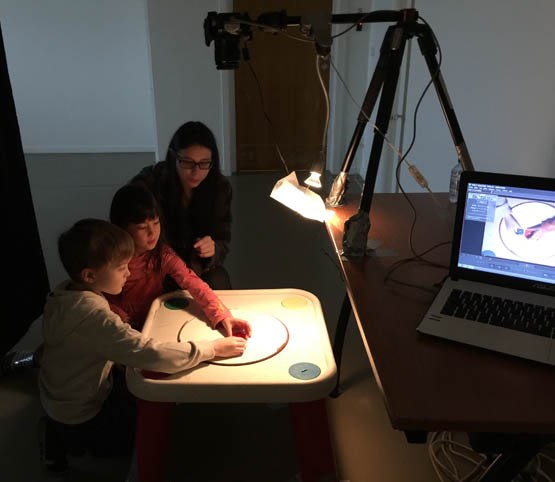
For the very youngest film goers there was face painting which turned even the youngest babies into tigers, butterflies and every other animal imaginable.
Each year Animated Night draws a large crowd that fills the main theatre and balconies up to the ceiling. Beginning at 21u30 (9:30 at night) 3 programs of films that were submitted to the festival but not selected for the competitions were screened. Between each screening there were 45 minute breaks to visit the bar and dance to music provided by animator Mirai Mizue turned DJ. The 15 Euro ticket price for 6 hours of film and music is one of the best deals in town. The audience was encouraged to come in their pajamas to participate in the pajama contest. Vivacious actress Stéphanie Coerten, who introduced the screenings and interviewed film makers on stage all 10 days of the festival skipped her usual haute couture and doned psychedelic print pants and fuzzy slippers to keep the audience awake throughout the long night.
The winner received a Best of Anima DVD and an original Mirai drawing. The audience also voted for their favorite. This year’s winner was Our Wonderful Nature – The Common Chameleon by Tomer Eshed from Germany. The extremely funny film tells us that the chameleon has no natural enemies and then took us on a very funny adventure as the chameleon goes hunting. I don’t want to spoil the end because I’m sure that the film will be shown at many other festivals.
Taboek, directed by Dutch animator Dario van Vree, produced by Tünde Vollenbroek with music by Nik Phelps led off Animated Night. The film about a young girl browsing in a book store who is unexpectedly drawn to a volume of kinky erotica led off Animated Night and set the tone for the long night of film which didn’t end until 3:30 in the morning.
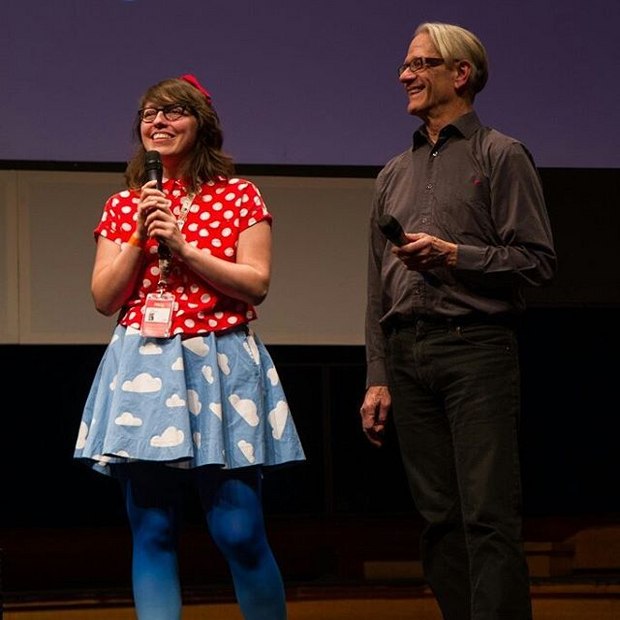
Virtual Reality came to Anima this year. Along with a panel discussion by VR professionals on creating and producing animated VR films, there was the opportunity to immerse yourself in a 360 degree VR experience courtesy of Poolplo Productions. Film maker Filip Sterckx and artist and gallery owner Anroon Verbeek created a clever visual installation using motion capture and video mapping. At a fun VR experience Anima visitors were invited to sit at a real dinner table set for a party with plates, silver wear, and a wine glass. A miniature chef appeared at each plate and prepared a virtual meal on your plate complete with entrée, vegetables, and ending with a dessert complete with a miniature Roman candle.
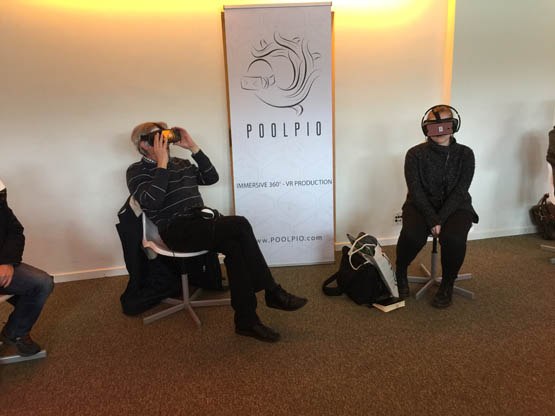
9e Concept brought together a group of artists to create stickers in the shape of a droplet called Francs Collers that could be stuck together to create a patchwork of different pictures. Using the free app for an iPhone or Android you could look at the different pictures in augmented reality and sound.
Following the closing night awards ceremony (a complete list of all winning films is at the end of the article) Ethel and Ernest directed by Roger Mainwood was screened. Based on Raymond Briggs’ graphic novel, the hand drawn film is a heartwarming tribute to the long, happy marriage of his parents Ethel and Ernest Briggs. From their courtship in the late 1920’s to their deaths a few months apart in 1971 the couple lived in a London suburb and raised their son Raymond. The film richly illustrates London working class life during some of the most momentous events of the 20th century. The Great Depression, World War II, the advent of television, and Neil Armstrong landing on the moon are seen through the eyes and discussed by this typical couple. Briggs is well known for When the Wind Blows and Snowman both of which have been turned into animated films that have become classics.
Congratulations to Festival Director Doris Cleven and Artistic Consultant Philippe Moins and their staff for putting together a festival full of excellent films, special programs, and special events.
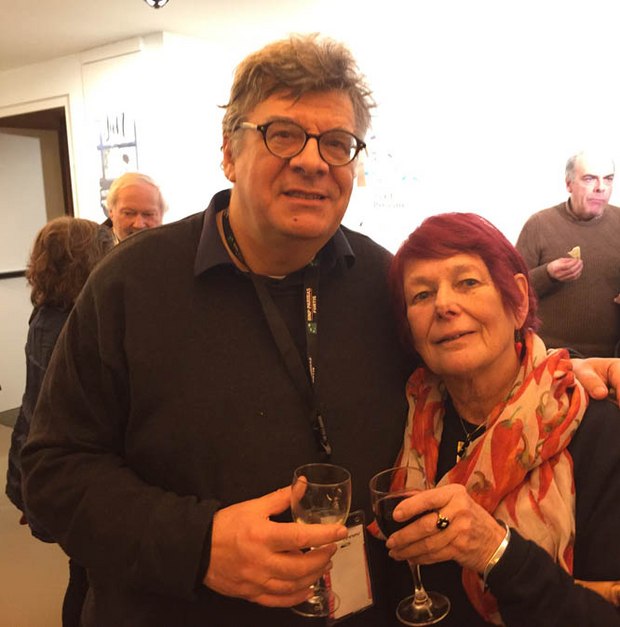
I owe a special debt of thanks to Noémie Meert from the press office and Karin Vandenrydt, guest liaison, for making my job so easy and pleasant. I am already looking forward to the 2018 edition of Anima Brussels which will take place from the 9th to the 18th of February. You can check out more of ANIMA Brussels at www.animafestival.be
INTERNATIONAL JURY AWARDS
Jury: Graham Annable, United States; Remi Durin, Belgium; Annette Schindler, Switzerland
Grand Prix for Best Short Film and 2500 Euros provided by Brussels-Capitol Region:
Among the Black Waves – Anna Budanova, Russia
Special Jury Award:
Decorado – Alberto Vazquez, Spain
Best Student Short Film (softwearlicense TVPaint Animation 11 Edition Standard):
My Father’s Room – Jang Nari, South Korea
Special Mention:
Asphalte – Lisa Matuszak, France
YOUNG JURY-Made up of representatives from webTV (acquisition of broadcast rights on Ouftivi)
La Cage – Loic Bruyere, France
Special Mention:
Jubile – Coralie Soudet, Charlotte Pioge, Marion Duvert, Marie El Kadiri, and Agathe Marion, France
AUDIENCE AWARDS
Best Animated Feature Film, awardprovided by FedEx (voucher worth 2.500 Euros):
Your Name – Makoto Shinkai, Japan
Best Animated Feature for Children:
Rabbit School – Ute von Munchow, Germany
Best Short Film:
Blind Vaysha – Theodore Ushev, Canada
Best Short Film for Children:
Jubilei – Coralie Soudet, Charlotte Pioge, Marion Duvert, Marie El Kadiri, and Agathe Marmion, France
Animation Night Audience Award for Best Short Film:
Our Wonderful Nature – The Common Chameleon –Tomer Eshed, Germany
PARTNER AWARDS
Best Animated Feature (5.000 Euros for acquisition of broadcasting rights):
The Anthem of the Heart – Tatsuyuki Nagai, Japan
Creative Revelation Award (2.500 Euros provided by the Korean Cultural Center):
Blind Vaysha – Theodore Ushev, Canada
Press Award for Best Short Film:
Fragments – Jose Miguel Ribeiro, Poortugal
NATIONAL COMPETITION
Jury – Jeroen Jaspaert, Belgium; Christine Polis, Belgium; and Ligia Soare, Romania
Best Belgian Short Film ( 2.500 Euros provided by Samba):
Catherine – Britt Raes
Grand Prix for Best Short of the Federation Wallonie-Brussels (2.500 Euros provided by the Federation of Wallonie-Brussels):
La Rentree desclasses – Stephane Aubier and Vincent Patar
Author Award (2.500 provided by SACD):
For a Fist Full of Girolles – Julien Grande
BELGIAN PARTNER AWARDS
BETV Award (Acquisition of broadcast rights):
69 Sec – Laura Nicolas
RTBF – La Trois Award ( acquisition of broadcasting rights)
Projection sur canape – Violette Delvoye
Cinergie Award (Electroniv Press Kit):
69 Sec – Laura Nicolas
